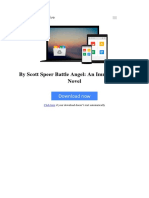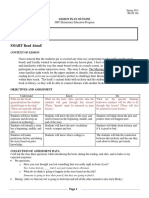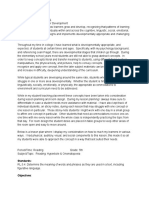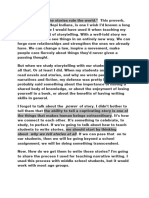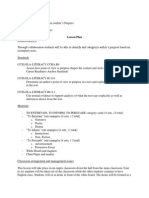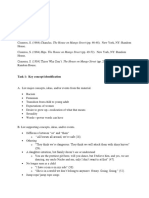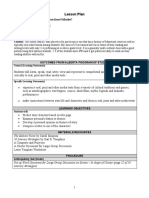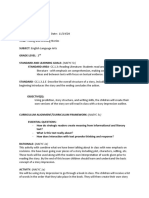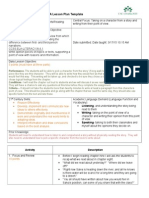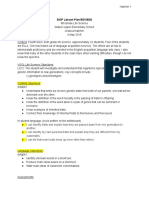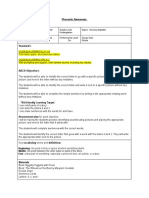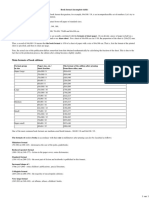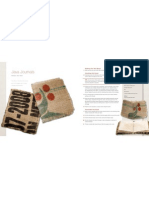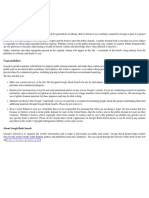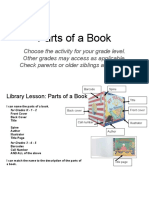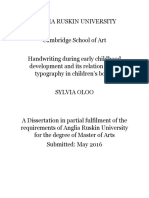The Power of The Picture Book: Teaching Techniques
The Power of The Picture Book: Teaching Techniques
Uploaded by
Hanelen Villegas DadaCopyright:
Available Formats
The Power of The Picture Book: Teaching Techniques
The Power of The Picture Book: Teaching Techniques
Uploaded by
Hanelen Villegas DadaOriginal Title
Copyright
Available Formats
Share this document
Did you find this document useful?
Is this content inappropriate?
Copyright:
Available Formats
The Power of The Picture Book: Teaching Techniques
The Power of The Picture Book: Teaching Techniques
Uploaded by
Hanelen Villegas DadaCopyright:
Available Formats
TEACHING TECHNIQUES
The Power of the
Picture Book
by LAURA LODER BUECHEL
There’s nothing better than a good picture a document projector, many of the techniques
book to get started on a new topic, to get can work with other seating arrangements.)
children involved in other worlds—and
to teach language in a low-pressure, THE COVER
relaxed setting. Trained teachers know
how to tell a good tale by using acting, Before you tell a story, you want to pique
their voice, and appropriate pacing. And this your learners’ interest. This can be done in
is often enough to get learners engaged in the many ways. With the following ideas, it is
tale and in the language. important that you don’t provide the title
right away—although options are to write
Yet sometimes we want more interaction the title on the board in scrambled letters for
and involvement from our learners—we learners to unscramble or to show the title
want to really get them producing language and have learners guess what the story will be
based on the pictures and the text and about. These activities generate language use
showing their comprehension visibly. Thus, and can be applied to any other pages in the
the aim of this article is to provide simple story, not just the cover. However, with the
techniques that can be used with almost any ideas below, you should not show the cover
picture book. The techniques applied here before you start the activity.
are appropriate for younger learners—
children in elementary school—but many • Take a blank piece of paper the size of the
of these techniques can be used with older book cover. Cut a “peephole” or the shape
learners; in my experience, even older of a magnifying glass into the sheet of
learners appreciate a good picture book paper. Place the paper over the book cover.
now and again, and there are many such Move the hole around so that different
books with meaningful messages aimed at parts of the cover can be seen by the
teens and adults. students. Each time you reveal a bit of the
cover, elicit language from the learners by
I have found The Sandwich Swap (2010), asking questions such as these: “What do
written by Rania Al Abdullah and Kelly you see?” … “Can you guess the title?” …
DiPucchio, and illustrated by Tricia Tusa, to “Who are the characters?”
be a story I am able to use every technique
described below with—although with any • Have the learners sit back to back—one
story I tell, I can use most of these techniques. faces you, and the other faces the back
The classroom setting can be simple—ideally, of the room. Put up a poster or use a
you will be able to sit with your learners in a blackboard in the back of the room for
circle where they can all see the pages. (With language support that helps learners ask
34 ENGLISH TEACHING FORUM 2 02 0 americanenglish.state.gov/english-teaching-forum
questions (e.g., “Who is on the cover?” don’t get stuck in the habit of calling only
… “Are there people on the cover?” … on specific volunteers. An alternative is
“What are they doing?” … “Do you see a to read the text without showing any of
specific place?”). The learner facing you can the pictures and, afterwards, elicit what
see the cover. The learner facing the back learners imagine in relation to what they
of the room can see only the supporting heard. You can then ask for their ideas
language. After a few minutes of asking and about what is under the post-it.
answering questions, the learners facing
the back of the room should have a picture • I don’t read the text—but I ask the
in mind about what is on the cover.You learners what they think could be under
can then ask those learners to turn around the post-it. Everyone has a chance to
and look at the picture (the cover of the speak. I tend to turn this into a pair listing
book).You might hear an “Oh!” as what activity: “With your partner, list ten things
the learners had pictured in their minds you think could be under this post-it. You
might not correspond with what they have one minute. Go!” Pairs can write
actually see. This—what they imagined and these things down or just tell them to
expected, and what they actually see—is a another pair after the minute is up. An
discussion point in and of itself. I have also option, if learners write the words, is to
used this technique with the book trailer if have one pair say one word, and if another
it is available online. One learner watches pair has that word, both pairs cross it off
but plugs their ears so they can’t hear, and their lists. After this, I reveal what’s under
the other learner faces the back of the the post-it, and we all say what it is in
room and only listens (but doesn’t see the unison: “It’s a hummus sandwich!” Then, I
trailer). Taking away one sense is a great read the corresponding part of the story to
way to get learners to compare notes and see if we were right!
ask/answer basic Wh– questions.
• I also use post-its simply to remind myself
POST-ITS what I want to do with that particular
page. Maybe there is a specific question
I prepare in advance by going through the to be asked? A word to be repeated? A
book and covering up certain pictures with listing/predicting/summarizing activity?
post-its. When I start telling the story, I say, Occasionally, I pass the post-it note to a
“Oh, my little daughter went through and learner who reads the question out loud to
stuck post-its all through my book! I wonder the class.
what’s under them!” Generally, I will have
a post-it covering something on every other EMBODIMENT
page or so, and I work with the post-its in the
following ways: Total physical response (commonly
referred to as “TPR”) activities are a way of
• I first read the text or tell a particular embodying language. In this approach, the
part of the story. Then, to see who was usual options of acting out words or lines and
listening or picked up on a specific word showing comprehension through movement
(for example, if I say, “She ate a hummus can be used. However, it can go a bit deeper.
sandwich,” then a picture of a hummus For instance, with The Sandwich Swap, but also
sandwich will be covered), I will say, other stories such as Lauren Child’s I Will Not
“My, what could be under this post-it?” Ever Never Eat a Tomato (2007), you can do the
after having read the text out loud. I say, following:
“Think about what is under the post-it.
At the count of 3, everybody shout what • If there’s food or a food fight in the story,
they think it is.” That way, every child says write a food item (e.g., “grapes”) on a
something (be it right or wrong), and I piece of paper. Show it to half the class,
americanenglish.state.gov/english-teaching-forum 2020 ENGLISH TEACHING FORUM 35
on one side of the circle or room. Those ROLE PLAYS AND INNER VOICE
students then pretend to “throw” the food
item at the students on the other side. The Role playing can be straightforward: you
other half of the class has to guess what dictate the lines of a short dialogue from the
is being thrown. This gets really funny story for the learners to write down, or you
for some kinds of food, such as Nutella or write the lines on the blackboard. Then, in
spaghetti. I have used this technique even pairs, learners read the lines out loud and
when there is not a food fight in the book, make appropriate actions and gestures. If you
but when food is simply mentioned. have the learners do this a few times, you can
erase or cover words each time. Once the
• There are often short dialogues in the learners “own” the role play, if there is space
story. Here, a little improvisation can in the classroom, have them do mingles and
work well on the sentence or word level. change partners and lines. I also like to have
For instance, you might have such a them experiment with voices—for example,
dialogue: as a robot, as a pirate, as a pirate talking to a
robot, and so on. With learners who are more
Charlie: I don’t like fish fingers! advanced, you can have them adapt the role
play and make it more or less formal (e.g.,
Lola: Why not? What about peas? learners pretend they are talking to an elderly
person they know or to their best friend).
In pairs, one learner reads the excerpt
out loud, and the other has to act it out, Inner-voice activities can work as role plays,
word by word—like an interpreter. but the learners create more of the text
Alternatively, let the learners read the themselves. For instance, in The Sandwich
dialogue quietly and act it out in pairs; Swap, you have, “She thought of her beautiful,
you can then read it to them so they hear smiling mother as she carefully cut Salma’s
the appropriate pronunciation. After sandwich into two neat halves that morning.”
that, the learners read it out loud in pairs The learners can say what the character is
together again. thinking—for example, “I love my sandwich.
My mother made it.” This technique works
• Saying one thing and showing something else as well with the pictures: if you take two of
helps strengthen learners’ listening skills. the food items in the food fight, pairs can
For instance, The Sandwich Swap starts, “It write a dialogue about what the food items
all began with a peanut butter and jelly are thinking. The Nutella might be thinking,
sandwich.” You read those lines, but you “Oh, I am so sticky. Don’t throw me! I want
show eating spaghetti. Then wait a minute, to be spread on bread!” And the grapes might
make a funny face, and see who can say, be thinking, “Ha! I am easy to throw! And I
“Not spaghetti—peanut butter and jelly!” bounce everywhere!”
The learners can then do this in pairs
with short lines from the text or at given QUESTIONS
moments in the story.
With any story, it’s important to ask questions
This last idea can be done by acting, but that elicit a lot of language and thought. For
also by having learners listen and look at this, Bloom’s Taxonomy question stems can
the pictures. For instance, in the story, be useful and are easy to find online. I tend
you might have a character who is clearly a to avoid questions that have only Yes/No
woman. Instead of reading “she,” you can answers, although I do try to mix simple,
read “he.” Or when the picture shows a one-word-answer questions with those
girl wearing a yellow sweater, you can say, that require more language. Figure 1 gives
“This story is about a girl who is wearing a examples, in order of complexity, that can
green sweater.” provide a basis for your own questioning. The
36 ENGLISH TEACHING FORUM 2 02 0 americanenglish.state.gov/english-teaching-forum
Questions about The Sandwich Swap What is elicited
How many girls is the story about? A precise number that can be counted or any number
How many children do you think are in the that makes sense, and the answer is not right or
cafeteria? wrong.
How do you spell “you’re” in “you’re great”? A specific target word
Write it in the air/on your partner’s back/
with your elbow.
What’s your favorite sandwich? Short utterances, different for everyone
What do you see that begins with an A? An alphabetical list of objects (apples) or chunks
With a B? (bubbly teachers) in which there are multiple answers
What did I just say? (After you read the A structure or paraphrase, depending on the
text, learners try to say it themselves. This is complexity of the language or whether you ask
especially useful—and fun—if you read with a learners to say it in their own words
lot of emotion.)
What do you think the principal said/did If you ask what happened afterwards, you will get a
after the girls left her office? lot of variation in structure and in answers (e.g.,
“She laughed” and “She rolled her eyes”).
What do you think will happen next? What Answers will range from single words to
was their great idea? short conversations. This can be treated as a
“think-pair-share.”
The girls started a food fight. How did they This is complex in thought and can be broken down
feel? How would you feel? Would you have into simpler parts.Yet it acts as a prompt to reflect on
handled the situation differently? one’s decisions and actions in retrospect, which can
be complex and requires learners to think about the
situation. The answer starting with “I would have … ”
can be the basis for a lot of language work.
Figure 1. Story-related questions and what they elicit
main part of the question is in bold and can be engagement by choosing students at random
applied to almost any book. or by making sure their cameras are on so you
can see them and react to their reactions as
ONLINE TEACHING you go.
Many of these ideas are also possible to use Enjoy!
when you are telling the story synchronously
online. Typically, the teacher reads, pauses, REFERENCES
and asks questions, and then perhaps uses
breakout rooms with Zoom or Microsoft Al Abdullah, R., DiPucchio, K., and Tusa, T. 2010. The
Teams or other video-conferencing tools for sandwich swap. Los Angeles: Disney Hyperion.
further work by pairs or small groups. The Child, L. 2007. I will not ever never eat a tomato. London:
screen-sharing functions on any of these Orchard Books.
tools work well for telling the story if it is
found as a PDF or other document type; they Laura Loder Buechel is a teacher-trainer at Zurich
also work for showing sentence starters and University of Teacher Education in Switzerland.
providing language support. When you are Her main passions are practicing what she preaches
reading the story to a group in this setting, in the elementary-school classroom and convincing
learners’ sound should be off unless they university students to think outside the box.
are speaking, and you can insist on their
americanenglish.state.gov/english-teaching-forum 2020 ENGLISH TEACHING FORUM 37
You might also like
- The Sohia CodeDocument10 pagesThe Sohia CodeKatarina Erdeljan22% (9)
- Living On Love - The Messenger by Klaus J. JoehleDocument154 pagesLiving On Love - The Messenger by Klaus J. JoehleLovesounds100% (7)
- Cambridge English B1 Preliminary For Schools EXAM TRAINER OXFORDDocument218 pagesCambridge English B1 Preliminary For Schools EXAM TRAINER OXFORDRosi Ivanova100% (1)
- SRSD Lesson PlanDocument4 pagesSRSD Lesson Planapi-357977200No ratings yet
- Complete: First Language EnglishDocument19 pagesComplete: First Language EnglishMaryam71% (7)
- Annie Lumsden, The Girl From The Sea by David Almond Chapter SamplerDocument13 pagesAnnie Lumsden, The Girl From The Sea by David Almond Chapter SamplerCandlewick Press0% (1)
- 7 2 Short Story LessonsDocument134 pages7 2 Short Story Lessonsanthonius19No ratings yet
- The Role of Print in The Rise of DemocracyDocument6 pagesThe Role of Print in The Rise of DemocracyMateusz Buczko100% (1)
- By Scott Speer Battle Angel An Immortal City Novel B00n4k00o4 PDFDocument5 pagesBy Scott Speer Battle Angel An Immortal City Novel B00n4k00o4 PDFtunga tungaNo ratings yet
- THE 5133-90 Fall 2016 Doctrine of The Pentecostal MovementDocument12 pagesTHE 5133-90 Fall 2016 Doctrine of The Pentecostal MovementWalter NixonNo ratings yet
- Yearbook Terms JeopardyDocument27 pagesYearbook Terms JeopardyjaimecreamNo ratings yet
- The US Brig Eagle (1814) - Model Ship BuilderDocument118 pagesThe US Brig Eagle (1814) - Model Ship Builderanon_835518017100% (1)
- Read Aloud Lesson PlanDocument4 pagesRead Aloud Lesson Planapi-252982922No ratings yet
- Simile Metaphor Lesson PlanDocument8 pagesSimile Metaphor Lesson Planapi-385521781No ratings yet
- Ed215r Lesson Plan 3Document4 pagesEd215r Lesson Plan 3api-218300742No ratings yet
- Read Aloud Lesson PlanDocument5 pagesRead Aloud Lesson Planapi-298336851No ratings yet
- Annotated-Edc 20360 - 20textual 20lineage 20lesson 20plans 20 26 20reflectionDocument7 pagesAnnotated-Edc 20360 - 20textual 20lineage 20lesson 20plans 20 26 20reflectionapi-591329757No ratings yet
- MC 2nd Term English Week 9 2023-2024Document10 pagesMC 2nd Term English Week 9 2023-2024Vanezzitta PachuchoNo ratings yet
- Intascstandard 1Document5 pagesIntascstandard 1api-272203292No ratings yet
- Writing Lesson PlanDocument4 pagesWriting Lesson Planapi-386069090No ratings yet
- Resource BookDocument8 pagesResource Booksayer_nicoleNo ratings yet
- Descriptive WritingDocument6 pagesDescriptive Writingvijthor100% (1)
- Read Aloud - Jmu Lesson Plan TemplateDocument4 pagesRead Aloud - Jmu Lesson Plan Templateapi-376073961No ratings yet
- 477 Lesson Plan Summer 2013Document12 pages477 Lesson Plan Summer 2013tddhondtNo ratings yet
- Madeline Hunter Template 3Document2 pagesMadeline Hunter Template 3api-653301870No ratings yet
- Teaching Young LearnersDocument7 pagesTeaching Young LearnersHakima BotirovaNo ratings yet
- Ugly Duckling. First GradeDocument6 pagesUgly Duckling. First GradeMaguie SarmientoNo ratings yet
- A Step-by-Step Plan For Teaching Narrative Writing - Jennifer GanzalezDocument13 pagesA Step-by-Step Plan For Teaching Narrative Writing - Jennifer GanzalezMsFraijNo ratings yet
- Student Teaching Grade 2 Lesson ElaDocument9 pagesStudent Teaching Grade 2 Lesson Elaapi-666768878No ratings yet
- Term III Literature Lesson Plan 1Document6 pagesTerm III Literature Lesson Plan 1api-269809853No ratings yet
- Analyzing Visual Elements: Learning ObjectivesDocument4 pagesAnalyzing Visual Elements: Learning ObjectivesGine FrencilloNo ratings yet
- Lesson Plan SharedDocument12 pagesLesson Plan Sharedapi-311349883No ratings yet
- Siop Lesson PlanDocument5 pagesSiop Lesson Planapi-522436373No ratings yet
- Students Own Language PDFDocument4 pagesStudents Own Language PDFpaolita1808No ratings yet
- Ed 462 - Digraph Bingo Lesson Plan Revised Jan 2013Document6 pagesEd 462 - Digraph Bingo Lesson Plan Revised Jan 2013api-285721106No ratings yet
- Lesson Plan Week 2Document4 pagesLesson Plan Week 2api-407289133No ratings yet
- SPC 4290 Tiered Lesson Plan PrintableDocument10 pagesSPC 4290 Tiered Lesson Plan Printableapi-354589761No ratings yet
- Arooj A-Fuzz Frenzy Pop Cycle 1 Lesson PlanDocument3 pagesArooj A-Fuzz Frenzy Pop Cycle 1 Lesson Planapi-698849093No ratings yet
- Text AnalysisDocument6 pagesText Analysisapi-376545390No ratings yet
- Pumpkin Patch Lesson PlanDocument4 pagesPumpkin Patch Lesson Planapi-315678845No ratings yet
- Grade: 5th Time: 25 - 30 Minutes: Standard: 3.4 Listening ComprehensionDocument9 pagesGrade: 5th Time: 25 - 30 Minutes: Standard: 3.4 Listening Comprehensionkrupak2107No ratings yet
- Day 2 WDocument3 pagesDay 2 Wapi-252551336No ratings yet
- Activating Comprehension: Non-Fiction in The Classroom: Teaching Children To Read, Good Readers AreDocument4 pagesActivating Comprehension: Non-Fiction in The Classroom: Teaching Children To Read, Good Readers AreAnthony KrippesNo ratings yet
- Open-Ended Activities: 1 Diaries or Student JournalsDocument5 pagesOpen-Ended Activities: 1 Diaries or Student JournalskalasantyNo ratings yet
- Lesson Plan OutlineDocument4 pagesLesson Plan Outlineapi-298364857No ratings yet
- Lesson Plan 2nd GradeDocument4 pagesLesson Plan 2nd Gradeapi-426934978100% (1)
- Writing Lesson Plan Template CAEP K-6 Standards Lesson RationaleDocument6 pagesWriting Lesson Plan Template CAEP K-6 Standards Lesson Rationaleapi-438623441No ratings yet
- Lesson Plan: General Learning Outcome(s)Document6 pagesLesson Plan: General Learning Outcome(s)api-526388634No ratings yet
- Hacc Lesson Plan 270Document4 pagesHacc Lesson Plan 270api-490353682No ratings yet
- Final Reading Lesson PlanDocument7 pagesFinal Reading Lesson Planapi-456570056No ratings yet
- Why It's So Important For Our Students To Stop Translating and Start Thinking in EnglishDocument9 pagesWhy It's So Important For Our Students To Stop Translating and Start Thinking in Englishsabbeena jowkinNo ratings yet
- Edu 321 Reading Lesson PlanDocument6 pagesEdu 321 Reading Lesson Planapi-637301231No ratings yet
- Direct Instruction Lesson Plan TemplateDocument4 pagesDirect Instruction Lesson Plan Templateapi-314110683No ratings yet
- Edu481 Lesson PlanDocument4 pagesEdu481 Lesson Planapi-732321886No ratings yet
- I Can Ask and Answer Questions Such As Who, What, Where, When, Why and How. I Can Refer To The Text To Find The AnswersDocument3 pagesI Can Ask and Answer Questions Such As Who, What, Where, When, Why and How. I Can Refer To The Text To Find The Answersapi-457202674No ratings yet
- Edtpa Lesson Plan Template: Ccss - Ela-Literacy - Rl.4.6Document3 pagesEdtpa Lesson Plan Template: Ccss - Ela-Literacy - Rl.4.6api-282838637No ratings yet
- Read Comprehension LP 1Document8 pagesRead Comprehension LP 1api-254523162No ratings yet
- Make Your Request Known Presentation:: Imperative SentenceDocument6 pagesMake Your Request Known Presentation:: Imperative SentenceyanlitNo ratings yet
- Edlaass 2 FinalDocument4 pagesEdlaass 2 Finalapi-357761286No ratings yet
- Lesson On Story ElementsDocument5 pagesLesson On Story Elementsapi-385152326100% (1)
- Step 1 - Examine A Piece of Poor WritingDocument8 pagesStep 1 - Examine A Piece of Poor WritingArshinta KuswardhaniNo ratings yet
- CT Observation Lesson PlanDocument3 pagesCT Observation Lesson Planapi-400377867No ratings yet
- Prepositions LessonplanDocument7 pagesPrepositions LessonplanAniger LeeNo ratings yet
- SIOP Lesson Plan REVISEDDocument7 pagesSIOP Lesson Plan REVISEDapi-357230012No ratings yet
- Edt 315 Module 4 Lesson Plan 2Document4 pagesEdt 315 Module 4 Lesson Plan 2api-550565799No ratings yet
- 341343422-Ed-427-Lesson-First-Observation 1Document5 pages341343422-Ed-427-Lesson-First-Observation 1api-350675434No ratings yet
- Lesson Plan 1: Fairness and EqualityDocument4 pagesLesson Plan 1: Fairness and Equalityapi-302200052No ratings yet
- The Literature Toolbox: Practical Strategies for Exploring TextsFrom EverandThe Literature Toolbox: Practical Strategies for Exploring TextsNo ratings yet
- English9 q1 Mod1of3 Modals V2Document14 pagesEnglish9 q1 Mod1of3 Modals V2Hanelen Villegas DadaNo ratings yet
- Practical Research 2Document26 pagesPractical Research 2Hanelen Villegas DadaNo ratings yet
- The Problem and Its Scope Rationale of The StudyDocument4 pagesThe Problem and Its Scope Rationale of The StudyHanelen Villegas Dada100% (1)
- Summary of Findings, Conclusion and RecommendationDocument2 pagesSummary of Findings, Conclusion and RecommendationHanelen Villegas DadaNo ratings yet
- Presentation, Analysis, and Interpretation of DataDocument4 pagesPresentation, Analysis, and Interpretation of DataHanelen Villegas DadaNo ratings yet
- Chapter IiDocument7 pagesChapter IiHanelen Villegas DadaNo ratings yet
- Chapter II FinalDocument7 pagesChapter II FinalHanelen Villegas DadaNo ratings yet
- Presentation, Data Analysis and Interpretation of Data: Rating Frequency Percentage % RemarksDocument4 pagesPresentation, Data Analysis and Interpretation of Data: Rating Frequency Percentage % RemarksHanelen Villegas DadaNo ratings yet
- The Problem and Its Scope Rationale of The StudyDocument4 pagesThe Problem and Its Scope Rationale of The StudyHanelen Villegas DadaNo ratings yet
- Book Format Table (Edition Standard)Document1 pageBook Format Table (Edition Standard)SMITH100% (1)
- Reading Technique PDFDocument37 pagesReading Technique PDFGedie RocamoraNo ratings yet
- How+to+Write+a+ReferenceDocument3 pagesHow+to+Write+a+ReferenceHina MuryamNo ratings yet
- Accounting Theory 7th Edition Godfrey PDFDocument7 pagesAccounting Theory 7th Edition Godfrey PDFNova TheresiaNo ratings yet
- EcoBooks JavaJournalDocument1 pageEcoBooks JavaJournalsthomps12No ratings yet
- Matthaei - Parisiensis - Chronica Maiora 1240-1247 Vol 4Document721 pagesMatthaei - Parisiensis - Chronica Maiora 1240-1247 Vol 4anthos_nouNo ratings yet
- Homework Helpers Chemistry Greg Curran PDFDocument4 pagesHomework Helpers Chemistry Greg Curran PDFcfb5xv2v100% (1)
- Constitution of India and Professional Ethics, 1/e: Book Information Sheet Book Information SheetDocument1 pageConstitution of India and Professional Ethics, 1/e: Book Information Sheet Book Information SheetDeepthi SonuNo ratings yet
- Abrir Toaz - Info Complete Ielts Band 65 75 Teacherbookpdf PRDocument129 pagesAbrir Toaz - Info Complete Ielts Band 65 75 Teacherbookpdf PRIan Franco ManniNo ratings yet
- Leo Alan - Astrology For All PDFDocument143 pagesLeo Alan - Astrology For All PDFnicholehuntsmanNo ratings yet
- ARTDEL UCLA-talk Q&A Seica 2020 Printout v3Document8 pagesARTDEL UCLA-talk Q&A Seica 2020 Printout v3VaniaMontgomeryNo ratings yet
- Vanderbilt University Press Spring/Summer 2021 CatalogDocument19 pagesVanderbilt University Press Spring/Summer 2021 CatalogVanderbilt University PressNo ratings yet
- Hit The Headlines PDFDocument193 pagesHit The Headlines PDFTin RANNo ratings yet
- Pf-Interior Design - Apr 08Document4 pagesPf-Interior Design - Apr 08Ar Shahanaz JaleelNo ratings yet
- CH 1 - The Fun They Had PPT 2Document31 pagesCH 1 - The Fun They Had PPT 2SA PERUMALNo ratings yet
- Givoni 1962 Bibliografia 4 PDF FreeDocument1 pageGivoni 1962 Bibliografia 4 PDF FreeAmosOtienohNo ratings yet
- XI Practicals ObjectsDocument16 pagesXI Practicals Objectsapi-19634868No ratings yet
- Library Parts of A BookDocument14 pagesLibrary Parts of A Bookapi-273340621No ratings yet
- Handwriting During Early Childhood DevelDocument35 pagesHandwriting During Early Childhood DevelOkuzeneNo ratings yet
- TR 60 - Tier 1 Series THN - 1998Document478 pagesTR 60 - Tier 1 Series THN - 1998Hendra MonoNo ratings yet








